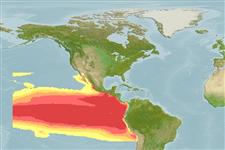Élasmobranches (requins et raies) (sharks and rays) >
Myliobatiformes (Stingrays) >
Mobulidae (Devilrays)
Eponymy: Walter Heinrich Munk (1917–2019) was an Austrian-born American oceanographer. [...] (Ref. 128868), visit book page.
Environment: milieu / climate zone / depth range / distribution range
Écologie
marin; océanodrome (Ref. 51243); profondeur 0 - 15 m (Ref. 58018). Tropical; 32°N - 7°S, 114°W - 77°W (Ref. 114953)
Eastern Pacific: From Gulf of California to Peru, incl. the Galapagos Is. (Ref. 130539).
Taille / Poids / Âge
Maturity: Lm ? range ? - ? cm
Max length : 220 cm WD mâle / non sexé; (Ref. 28023); common length : 100.0 cm WD mâle / non sexé; (Ref. 9256)
Pelagic species forming schools in coastal and oceanic waters, but also found near the bottom. Found singly, in small groups, or in schools (Ref. 12951). Feeds mainly on planktonic crustaceans, but also takes small schooling fishes (Ref. 12951). Ovoviviparous (Ref. 50449). Gestation period unknown (Ref. 114953).
Life cycle and mating behavior
Maturité | Reproduction | Frai | Œufs | Fécondité | Larves
Exhibit ovoviparity (aplacental viviparity), with embryos feeding initially on yolk, then receiving additional nourishment from the mother by indirect absorption of uterine fluid enriched with mucus, fat or protein through specialised structures (Ref. 50449).
McEachran, J.D. and G. Notarbartolo di Sciara, 1995. Mobulidae. Mantas, diablos. p. 759-764. In W. Fischer, F. Krupp, W. Schneider, C. Sommer, K.E. Carpenter and V. Niem (eds.) Guia FAO para Identification de Especies para los Fines de la Pesca. Pacifico Centro-Oriental. 3 Vols. FAO, Rome. (Ref. 9256)
Statut dans la liste rouge de l'IUCN (Ref. 130435: Version 2024-1)
Menace pour l'homme
Harmless
Utilisations par l'homme
Pêcheries: commercial
Outils
Articles particuliers
Télécharger en XML
Sources Internet
Estimates based on models
Preferred temperature (Ref.
123201): 22.2 - 28.5, mean 23.5 °C (based on 368 cells).
Phylogenetic diversity index (Ref.
82804): PD
50 = 0.5005 [Uniqueness, from 0.5 = low to 2.0 = high].
Bayesian length-weight: a=0.01000 (0.00244 - 0.04107), b=3.04 (2.81 - 3.27), in cm total length, based on all LWR estimates for this body shape (Ref.
93245).
Niveau trophique (Ref.
69278): 3.8 ±0.60 se; based on food items.
Résilience (Ref.
120179): Faible, temps minimum de doublement de population : 4,5 à 14 années (Fec assumed to be <100).
Fishing Vulnerability (Ref.
59153): Very high vulnerability (85 of 100).
